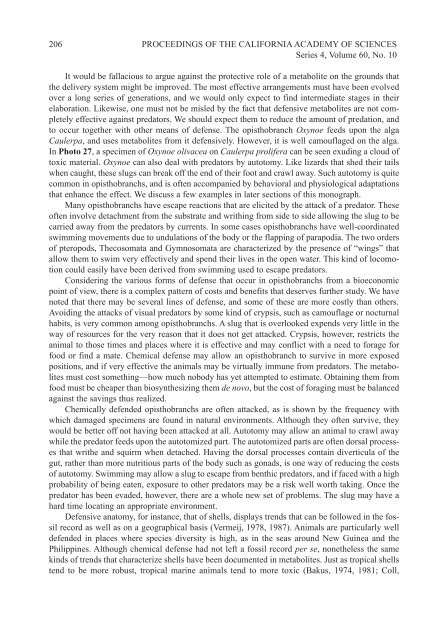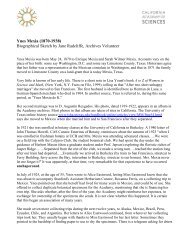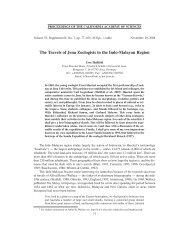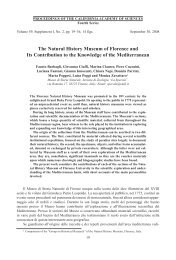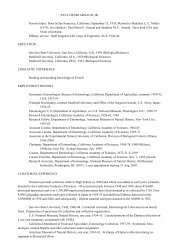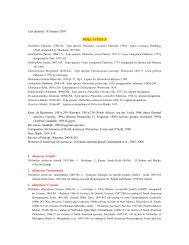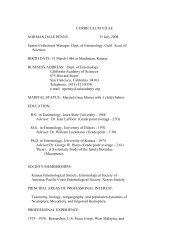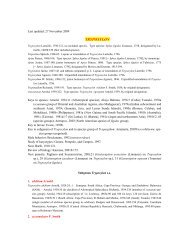Cimino&Ghiselin-tmpZXYZ:Template Proceedings_1.qxd.qxd
Cimino&Ghiselin-tmpZXYZ:Template Proceedings_1.qxd.qxd
Cimino&Ghiselin-tmpZXYZ:Template Proceedings_1.qxd.qxd
Create successful ePaper yourself
Turn your PDF publications into a flip-book with our unique Google optimized e-Paper software.
206 PROCEEDINGS OF THE CALIFORNIA ACADEMY OF SCIENCES<br />
Series 4, Volume 60, No. 10<br />
It would be fallacious to argue against the protective role of a metabolite on the grounds that<br />
the delivery system might be improved. The most effective arrangements must have been evolved<br />
over a long series of generations, and we would only expect to find intermediate stages in their<br />
elaboration. Likewise, one must not be misled by the fact that defensive metabolites are not completely<br />
effective against predators. We should expect them to reduce the amount of predation, and<br />
to occur together with other means of defense. The opisthobranch Oxynoe feeds upon the alga<br />
Caulerpa, and uses metabolites from it defensively. However, it is well camouflaged on the alga.<br />
In Photo 27, a specimen of Oxynoe olivacea on Caulerpa prolifera can be seen exuding a cloud of<br />
toxic material. Oxynoe can also deal with predators by autotomy. Like lizards that shed their tails<br />
when caught, these slugs can break off the end of their foot and crawl away. Such autotomy is quite<br />
common in opisthobranchs, and is often accompanied by behavioral and physiological adaptations<br />
that enhance the effect. We discuss a few examples in later sections of this monograph.<br />
Many opisthobranchs have escape reactions that are elicited by the attack of a predator. These<br />
often involve detachment from the substrate and writhing from side to side allowing the slug to be<br />
carried away from the predators by currents. In some cases opisthobranchs have well-coordinated<br />
swimming movements due to undulations of the body or the flapping of parapodia. The two orders<br />
of pteropods, Thecosomata and Gymnosomata are characterized by the presence of “wings” that<br />
allow them to swim very effectively and spend their lives in the open water. This kind of locomotion<br />
could easily have been derived from swimming used to escape predators.<br />
Considering the various forms of defense that occur in opisthobranchs from a bioeconomic<br />
point of view, there is a complex pattern of costs and benefits that deserves further study. We have<br />
noted that there may be several lines of defense, and some of these are more costly than others.<br />
Avoiding the attacks of visual predators by some kind of crypsis, such as camouflage or nocturnal<br />
habits, is very common among opisthobranchs. A slug that is overlooked expends very little in the<br />
way of resources for the very reason that it does not get attacked. Crypsis, however, restricts the<br />
animal to those times and places where it is effective and may conflict with a need to forage for<br />
food or find a mate. Chemical defense may allow an opisthobranch to survive in more exposed<br />
positions, and if very effective the animals may be virtually immune from predators. The metabolites<br />
must cost something—how much nobody has yet attempted to estimate. Obtaining them from<br />
food must be cheaper than biosynthesizing them de novo, but the cost of foraging must be balanced<br />
against the savings thus realized.<br />
Chemically defended opisthobranchs are often attacked, as is shown by the frequency with<br />
which damaged specimens are found in natural environments. Although they often survive, they<br />
would be better off not having been attacked at all. Autotomy may allow an animal to crawl away<br />
while the predator feeds upon the autotomized part. The autotomized parts are often dorsal processes<br />
that writhe and squirm when detached. Having the dorsal processes contain diverticula of the<br />
gut, rather than more nutritious parts of the body such as gonads, is one way of reducing the costs<br />
of autotomy. Swimming may allow a slug to escape from benthic predators, and if faced with a high<br />
probability of being eaten, exposure to other predators may be a risk well worth taking. Once the<br />
predator has been evaded, however, there are a whole new set of problems. The slug may have a<br />
hard time locating an appropriate environment.<br />
Defensive anatomy, for instance, that of shells, displays trends that can be followed in the fossil<br />
record as well as on a geographical basis (Vermeij, 1978, 1987). Animals are particularly well<br />
defended in places where species diversity is high, as in the seas around New Guinea and the<br />
Philippines. Although chemical defense had not left a fossil record per se, nonetheless the same<br />
kinds of trends that characterize shells have been documented in metabolites. Just as tropical shells<br />
tend to be more robust, tropical marine animals tend to more toxic (Bakus, 1974, 1981; Coll,


